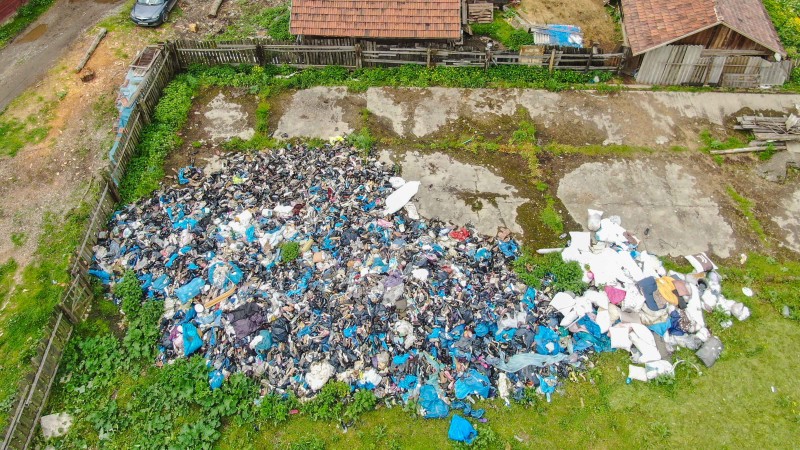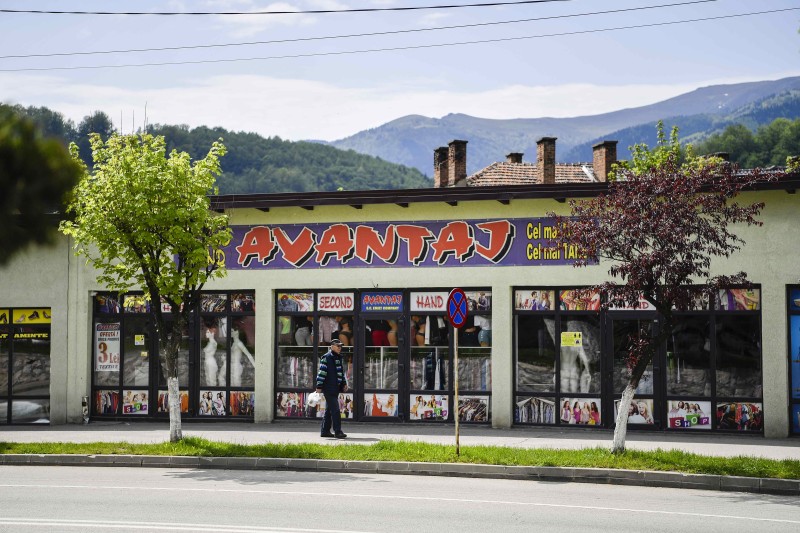Reported by
In southwest Romania, grazing cows gaze out across a field. It should be an idyllic countryside scene — but instead of a sea of grass, what lies before them is an unsightly mound of shirts, shoes, underwear, and other textile scraps.
The clothes were “dumped here over time,” explains Vasile, a 50-year-old whose family lives next to the massive garbage pile, one of many blighting the region known as the Jiu Valley.
On cold winter nights, he and other locals on the outskirts of the impoverished city of Petrosani turn to the discarded clothing as a free source of fuel. They are so accustomed to burning old clothes that they have a classification system for which are most desirable, with blue jeans at the top (they burn slow and hot) and shoes at the bottom (they emit terrible fumes).
“That black smoke from chimneys is from clothes and shoes,” Vasile told a reporter who visited him at home on a cold day. “They have no alternative. They don’t have the money to buy wood.”
A closer look at the pile of clothes, which also includes old newspapers, medical waste, and other trash, reveals labels written in a foreign language: German. That’s because this illegal dump is the endpoint of a cross-border secondhand clothing trade with a dirty secret.
A pile of trash on the outskirts of Petroșani City in Romania.
Europe’s used clothing industry pitches itself as an environmentally-friendly fix for the era of fast fashion, in which cheap clothes are produced, purchased, and disposed of at an increasingly rapid rate. In wealthier European countries, streetside collection bins for used clothes are often plastered with do-gooder slogans such as “Join in, for the sake of the environment!” The implication is that clothes placed in these bins will be donated for a worthy cause.
But the reality is not always as pretty — or as green. Often, the highest quality clothes collected in the donation bins are resold locally, but lower-grade items, including a significant amount of dirty, torn or otherwise unusable pieces, are exported to Eastern Europe or developing countries in Africa.
The receiving nations often end up with large amounts of unusable clothing that is ultimately dumped or burned. Dubbed “waste colonialism,” this transfer of textile waste from rich to poor countries — often in the guise of philanthropy — has been well-documented in countries such as Ghana, Kenya, and Chile, which import large volumes of used clothing from Europe.
But less is known about the flow of worn textiles within the European Union itself. An investigation by OCCRP and its Romanian partner RISE offers insight into how the well-intentioned trade often backfires, with uneven legislation and weak oversight creating channels for large amounts of textile waste to flow untraced across frontiers and, in the case of Romania, end up in fields and rivers.
Old clothes are sometimes dumped in the Jiu river in Southern Romania. The Jiu Valley is a hub for companies importing secondhand clothes into Romania.
But 14 court complaints obtained by OCCRP and RISE alleged that some Romanian importers have been glossing over these distinctions. These complaints, which were filed by environmental and consumer protection authorities in the past four years, accuse 11 Romanian firms of illegally importing unsorted textile waste and discarding much of it improperly. (All of these cases are still being investigated by prosecutors, and no charges have been filed against any of the companies, although civil fines have been issued in some cases.)
“Huge amounts of waste end up being illegally disposed of in landfills or are simply thrown on the riverbeds,” reads one complaint. In the impoverished Jiu Valley, a hub for secondhand importers, the main river is “practically choked with textile waste”
The dumps are more than an eyesore. Most clothing produced today consists largely of synthetic materials, meaning that the tossed items are effectively a form of plastic pollution that can taint soil and waterways.
“The synthetic nature of the clothes is really a problem because there's no path for it to degrade,” said Madeleine Cobbing, a Researcher for Greenpeace Germany's Overconsumption & Detox My Fashion Campaign, who has authored a report on used clothing imports in East Africa. “Those clothes washing on the river banks, they'll all be breaking up into pieces and forming microplastic fibers. It'll be getting into the food chain.”
Secondhand clothes from Europe being sold at a market in Nairobi, Kenya.
“The Last Person Has the Problem”
As fast-fashion giants churn out increasingly cheap clothes, more and more people are buying them — and discarding them. Per capita consumption of clothing in the EU has increased some 20 percent between 2003 and 2018. In response, the EU has tried to reduce clothing waste by encouraging reuse. Currently, an average of 38 percent of used clothing in the EU is collected for reuse and recycling, but starting next year, all member states will be required to collect used textiles separately from other trash, which should increase this figure significantly.
But the fate of what is donated is often unclear. According to the European Economic Area, some 10 percent of donated clothes are resold locally in the same country, while another 10 percent is sold on to other EU countries and the rest goes abroad, chiefly to Africa and Asia.
With each stop, the quality of the clothing decreases.
“Everyone picks up what they like, and then they export it to the next person who picks up what they like, and then the last person has the problem,” explained Ola Bąkowska, an expert on textiles from the Circle Economy, an organization that produces reports on economic strategies to reduce waste.
Many of the Baltic and Eastern European countries that import used clothing from Western member states are also major exporters, meaning that after they sort out the best items the rest is sent onwards to buyers outside the EU. Romania, however, is chiefly an end customer in the chain, importing tens of thousands of tons of used clothing annually and exporting only a small fraction.
According to the U.N.’s Comtrade database, an average of 58,000 tons of used clothing was trucked into Romania annually between 2020 and 2023. The top supplier during this period was Germany, which is one of the world’s leading exporters of used clothing and has accounted for some 50 percent of Romania's imports over the past four years
While there are no precise figures on how many of these incoming shipments do not meet Romanian standards (which require incoming textiles to be sanitized and sorted so they do not include any non-textile items), data and documents obtained by RISE show that border police have stopped trucks carrying what was deemed to be illegal textile waste on a nearly monthly basis between 2021 and 2023, mostly coming from EU countries like Germany, Austria, and the Netherlands.
There are likely far more trucks carrying dirty clothes into Romania that are never stopped, since the Environmental Guard Agency only works during daytime hours, and the trucks often slip in at night. To avoid inspection, some even carry two sets of documents to present to different Romanian enforcement bodies. Environmental inspectors, who only have the authority to inspect incoming waste, might be given documents saying the truck is carrying secondhand clothes. But when the Consumer Protection Authority, responsible for inspecting secondhand clothes, comes by, they'll be handed different documents claiming the truck is carrying waste.
Of the trucks that were successfully stopped at the border, one was found to be carrying clothing that was “dirty, stained, with mold,” reads a document issued by the Environmental Guard Agency. Another shipment included non-textile items like CDs, children’s toys, and dirty shoes.
Items presented as secondhand clothing discovered by Romania's Consumer Protection Authority during a 2022 raid of an incoming shipment from Hungary.
“These secondhand goods are actually waste in disguise,” the National Environmental Guard Commissioner, Andrei Corlan, told RISE.
There is a strong economic rationale for sending shipments like this to poorer EU countries like Romania. In Germany, the cost of waste disposal runs from 200 to 300 euros per ton — roughly 10 times higher than the cost of doing it in Romania, according to a 2022 internal report from Romania’s Ministry of Internal Affairs.
“We have a situation where waste generators from abroad send waste to Romania to get rid of what they don’t want to eliminate on their territory because it is more expensive to do it there than it is in Romania,” said Corlan
On the Romanian end, there are also financial advantages, he said. Purchasing large shipments of “mixed” textiles is very cheap, and a small percentage of those textiles can be recovered and sold in secondhand shops.
When the companies need to deal with the clothes that are too dirty to sell, he said, they offload it onto Romania’s poorest communities, like the one where Vasile lives.
“This portion is loaded into black bags that are sold at a low price to various poor communities,” he said. “These communities also make a selection, after which the rest of the worst-quality imported products end up being thrown into the fields or into waterways.”
From a German Bin to a Romanian Dump
To understand how the used clothing trade can run awry, reporters traced a supply chain from one German exporter to a Romanian importer that environmental inspectors accused of illegally importing and discarding waste.
The exporter, a private firm named Baliz Textilwerke that collects clothing from thousands of bins in western and southern Germany, sets out a laudable mission statement on its website. (Baliz Textilewerke did not respond to multiple requests for comment sent by OCCRP and RISE.)
“We have made it our task to recycle wearable clothing and shoes and thus make our contribution to environmental protection,” it reads. “The mountains of rubbish are constantly increasing.”
It says on its website that it separates clothes from other items, such as shoes, toys, belts, and bags, before sending the shipments to countries including Romania, Poland, Italy, and Spain.
But according to inspection reports and transport documents, Baliz Textilwerke’s exports to at least four Romanian companies in the Jiu Valley included used clothing mixed in with other items, such as “carpets, quilts, pillows, used or very used leather goods and household goods” — which, under Romanian law, should be classified as textile waste, since they were unsorted. None of these Romanian importers Baliz Textilwerke sold to were authorized by the Romanian waste registry to import waste when the investigations started.
Inspectors also described opening several bales of clothing during raids and finding products “in different stages of use, with stains, hair, and some of them ruptured,” even though some of Baliz Textilwerke’s shipments were accompanied by certificates stating they had been disinfected.
When reached for comment, one of the firms listed as responsible for the cleaning, a German company called WISAG Gebäudereinigung Hessen Nord GmbH & Co. KG, told RISE that it had only disinfected the exterior of the boxes and bags containing the textiles – not the actual clothing inside. The company said it wasn’t even equipped to disinfect or sanitize textiles, and had never offered such a service.
One of Baliz Textilwerke’s major customers in Romania is the Jiu Valley-based Emily SRL, which imports thousands of tons of textiles annually from Baliz. Emily runs secondhand clothing shops in cities around Romania, where it sells some of the clothes it imports.
An Emily secondhand store in Lupani, Romania.
But not all the textiles make it to these shops. Environmental Guard Inspectors raided the company’s depot twice in 2022 and again in 2023, with each inspection ending with a legal complaint filed with prosecutors and fines of up to $50,000 for breaking the environmental legislation. Prosecutors told RISE they had opened two cases against Emily after receiving the complaints, but are still investigating whether the company had committed a crime. (No indictment has been issued in either case.).
According to the complaints, after sorting out the sellable items from Baliz Textilwerke’s imports, the company was left with large quantities of unusable textiles and other products — over 100 tons in 2022, for example — that could not be sold in its clothing shops.
The company was not equipped to import such waste at the time — that would have required being registered on a platform run by environmental authorities, and proving that it had the facilities or contracts to ensure the waste would be properly recycled instead of dumped.
Not only did Emily lack such recycling facilities, inspectors found, but only a small portion of the waste it generated was sent to recycling firms. Instead, the company was storing its waste in a two-story warehouse and eventually “hand over” or sell the bags to “unauthorized individuals” for as little as 20 euro cents.
The bags would later be “disposed of illegally in landfills by these people, or simply thrown away on the riverbeds…or on the side of the roads where the waste is set on fire,” the files note.
Reporters who visited one of Emily’s depots in Uricani city found a one-story building filled to capacity with bags and clothes. Inside, the windows were sealed shut with black plastic. After requesting an interview with the company’s owner, Ion Duman, reporters were told by a local manager that “the boss is not available.”
An Emily SRL warehouse filled with bags and clothes in Uricani, Romania.
While Emily has since become a registered waste importer, a 2024 raid by the Consumer Protection Agency found that problems continue; its washing capacity was far lower than the volume of clothes it imported, leading to fines amounting to around $6,000.
A representative of Emily said the company had appealed the imposition of these fines, and would not comment on the case until a final decision had been reached.
"All imports of used textile came from authorized companies from Germany,” the company said. “The reception of the products was made in Romania and in case the imports contains other used products, these were returned to Germany. All the imports from Germany were accompanied by certificates. Before being placed on the market, Emily Company sorted the products depending on the quality status."
At least 10 other companies in the country — half of them in the Jiu Valley, one of Romania’s poorest regions — face similar allegations of illegally importing waste under the guise of secondhand clothing. Three of those importers are also alleged to have sent the unusable items directly to municipal garbage depots, which is against the law.

A Humana secondhand shop in Bucharest, Romania.
Humana Also Faces Accusations of Bringing Dirty Clothes Into Romania
A local company affiliated with Humana People to People, a global leader in the secondhand clothing industry, has also failed environmental inspections on the clothes it has brought into Romania.
A Legal Gray Zone
Since legal definitions and reporting requirements vary across EU member states, reliable data about the bloc’s secondhand clothing trade is hard to come by.
“There's a huge lack of knowledge” about the sector, said Lars Mortensen, an expert with the European Environment Agency which has produced several reports on the textile industry in recent years.
“Once we looked into it, we saw the amounts were really, really huge, and the trade flows were much more complex than we ever envisaged.”
One factor that contributes to the type of dumping seen in Romania and elsewhere is the lack of a clear definition of “textile waste” in EU law, meaning the stage at which used clothing is considered waste differs between member states. There are also no common criteria for what steps must be taken for a piece of used clothing to be prepared for reuse.
In Germany, for instance, donated clothing is considered waste until it undergoes sorting. But cleaning — which is mandated by Romania for the item to become secondhand clothing — is not required.
“There are no rules in Germany about washing textiles before they are exported,” said Viola Wohlgemuth, a former Greenpeace campaigner specializing in textile waste, told RISE. “Only shipping containers are fumigated in accordance with international transport rules and port rules, as are all shipping goods. But that's not textile-specific.”
An abandoned building in Aninoasa, Romania, formerly occupied by a company involved in the secondhand textile trade, is now filled with thousands of bags containing textiles, as well as items like shoes and books.
This mismatch is visible in some of Baliz Textilwerke’s exports to Romania, which inspectors found were accompanied by two sets of documents — one labeling them as textile waste and another as used clothing.
The same issue applies to exports shipped outside the EU. According to an EEA report, a large amount of the EU’s exports are labeled under the broad category of “worn textiles,” which often includes large amounts of unsorted items that are unfit for reuse.
The European Commission is working on a new strategy that would develop specific EU-level criteria to distinguish between waste and secondhand textile products.
A proposed revision of the Waste Framework Directive would also introduce new rules, such as sorting obligations, to ensure that what is shipped as used textiles are in fact fit for reuse.
Such labeling would be of particular help at the start of next year, when EU members will be required to collect textiles separately from other waste – a measure projected to increase the collection rates of used clothing but also see an overall decrease in the quality and a need for more rigorous sorting.
“There's a huge challenge with lack of sorting capacity and lack of recycling capacity. This is what creates these trade flows,” said Mortensen.
Currently, the level and quality of sorting is linked to the price a buyer is willing to pay, explained Bąkowska from the Circle Economy.
“If you're a best paying client, you get more selected stuff. But if you're a medium paying client, you get a little bit of everything… one bale is going to be better and one bale is going to be worse.”
For its part, Romania is drafting legislation that aims to better control the flow of secondhand goods into the country and will require importers to have facilities such as industrial washing systems, and to return any unusable items to the supplier.
“If the situation of secondhand products will be regulated and if the procedure for issuing the environmental authorisation for the waste component will be regulated, then, certainly, Romania will be much less attractive for illegal waste disposal,” said Corlan.
In the meantime, ordinary Romanians are paying the price, he said: “The Romanian public budget bears this expense of cleaning the areas and storing waste in landfills.”
Abandoned clothing and other items dumped in a neighborhood on the outskirts of Petroșani, Romania.
For locals like Vasile, the prospect of reforms leaves him with mixed feelings. He says he resents the Jiu Valley’s textile importing companies for the mess they create in the valley, but he and other hundreds of families have now come to depend on the fact that there will be an ample supply of dumped textiles to burn every winter.
"Do you think I prefer burning shoes instead of wood?” he said, “I do not… It stinks But at least we have means to heat the house."
Correction: This article was updated to correctly state that Humana People to People Romania SRL, not the affiliated Swiss-based umbrella group Humana People to People, was fined by Romanian inspectors.














